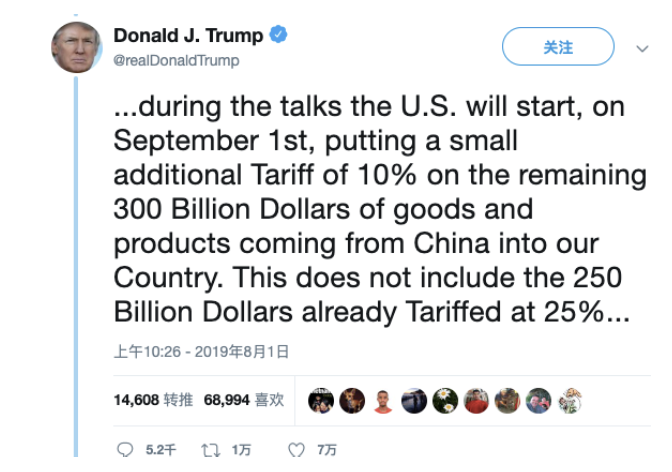
albert Chan
Recent Developments: From Cease-Fire To Surprising Escalation
We continue our coverage of US-China trade issues with a review of the latest developments and a timeline of how we got here. The US had already levied tariffs on $250 billion worth of Chinese imports when it announced a further 10% import tax in the remaining $300 billion in goods the US imports every year, meaning virtually all products imported from China into the US are now subject to punitive tariffs.
For its part, China has imposed tariffs on $110 billion worth of US goods – but the biggest weapon is its purchases of agricultural products, which it has cut or shifted to source from other countries.
How did we get here?
In June and July, there were signs of a cease-fire and hopes for a resolution:
- June 29: US President Donald Trump and Chinese President Xi Jinping met and agreed to an apparent truce: The US committed to not imposing tariffs on the remaining $300 billion worth of Chinese goods the US imports from China each year as had been previously threatened.
- July 30-31: The two sides met for high-level trade talks in Shanghai, which ended with a statement from the White House that China committed to purchase more agricultural products. And according to state-owned China Central Television (CCTV) news millions of tons of US soybeans have been loaded to ship to China and Chinese buyers are purchasing products such as cotton, pork, corn and wheat.
- August 1: President Trump announced he would impose “a small additional tariff of 10%” on the remaining $300 billion Chinese imports not currently subject to tariffs starting September 1. Most of the goods on the list are consumer goods including $44.8 billion smart phones, $38.7 billion laptops, $11.9 billion toys, $5.4 billion video gaming consoles, according to US International Trade Commission.
 Donal J. Trump’s tweet on August 1, 2019, 10:26am
Donal J. Trump’s tweet on August 1, 2019, 10:26amSource: Twitter[/caption] After the announcement, London’s main index lost 2% and Frankfurt fell 2.5%. Tokyo’s benchmark was off 2.1% and Hong Kong retreated 2.5%. Markets in Shanghai, Sydney and Paris also fell.
- August 2: China responds, with CCTV reporting Foreign Ministry spokeswoman Hua Chunying saying, “if the US measures to impose tariffs on the $300 billion Chinese goods are implemented, China will take all necessary counter-measures to defend the core interest of its people.” Hua also said the move by the US government was a “serious violation” of the agreement reached in Osaka and that “China is strongly dissatisfied and strongly opposes it,” repeating that “China does not want to fight, but is not afraid to fight.”
- August 5: China’s currency sinks to the lowest level in nearly a decade, below seven to the US dollar, making Chinese exports cheaper in the US and partially offsetting the impact of the tariffs.
